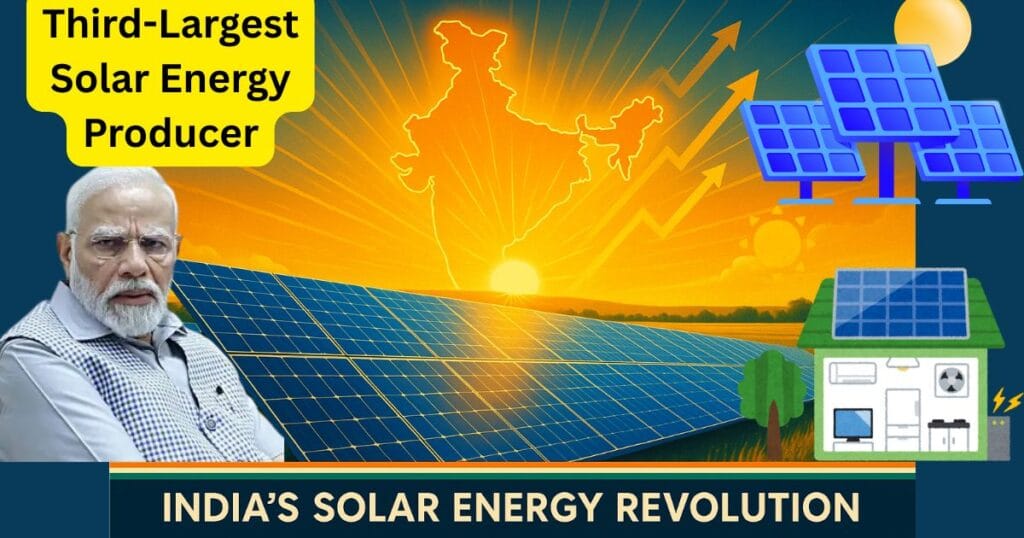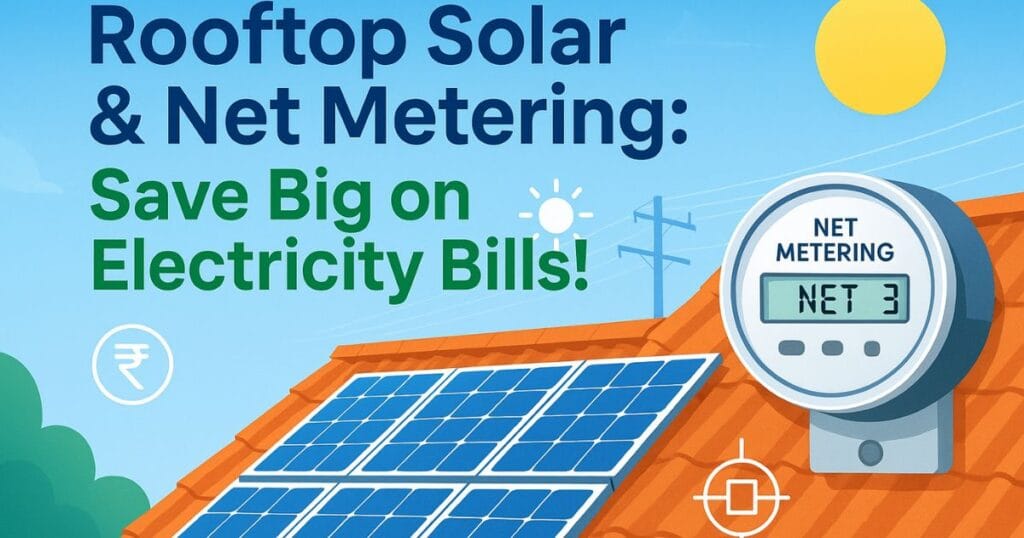India has overtaken Japan in 2025 to become the world’s third-largest solar energy producer. Discover how India achieved this milestone, the role of policies, major projects, and what lies ahead for its solar energy journey.

What is Solar Energy and Why is it Important?
Solar energy is electricity generated from sunlight using solar panels. It’s a clean, eco-friendly energy source that doesn’t pollute the environment like coal or oil. In a country like India, where electricity demand is skyrocketing, solar energy offers a cost-effective and sustainable solution. It not only reduces electricity bills but also helps combat climate change by cutting down harmful emissions.
India’s New Global Ranking in Solar Energy (Third-Largest Solar Energy Producer)
In 2024-25, India produced 108,494 gigawatt-hours (GWh) of solar energy, surpassing Japan’s 96,459 GWh to claim the Third-Largest Solar Energy Producer. Here’s how the top solar energy producers stack up:
| Country | Solar Energy Production (2024-25, GWh) | Installed Capacity (2024, MW) |
|---|---|---|
| China | 584,000 | 887,930 |
| United States | 238,000 | 177,470 |
| India | 108,494 | 97,384 |
| Japan | 96,459 | 89,077 |
Source: IRENA
This achievement (Third-Largest Solar Energy Producer) is a result of strong government policies, private sector efforts, and India’s abundant sunlight.
How Did India Overtake Japan?
India’s solar energy production in 2024-25 was about 12% higher than Japan’s. Here are the key reasons behind Third-Largest Solar Energy Producer:
- Government Support: India’s National Solar Mission and Production Linked Incentive (PLI) scheme have made it easier to manufacture and install solar panels.
- Rising Demand: India’s growing electricity needs have pushed the adoption of solar energy as a cheap and reliable option.
- Japan’s Slowdown: Japan’s solar market is mature, and its electricity demand has stagnated, slowing its growth.
- Affordable Technology: Solar panels in India have become cheaper, and new technology produces more electricity efficiently.
India’s Solar Energy Boom: Role of States in Third-Largest Solar Energy Producer
India’s solar capacity has grown from just 2.82 gigawatts (GW) in 2014 to an impressive 116.24 GW by 2025—a 40-fold increase! Some states have played a starring role in Third-Largest Solar Energy Producer:
- Rajasthan: Over 33 GW of solar capacity, thanks to abundant sunlight.
- Gujarat: Around 10 GW, home to major solar parks.
- Karnataka: 8 GW, with projects like Pavagada Solar Park.
- Tamil Nadu and Maharashtra: Contributing 5-7 GW each.
Major Solar Parks
- Bhadla Solar Park (Rajasthan): 2,245 MW, the world’s 11th largest solar park.
- Pavagada Solar Park (Karnataka): 2,050 MW.
- Kurnool Solar Park (Andhra Pradesh): 921 MW.
- Rewa Solar Park (Madhya Pradesh): 750 MW.
These solar parks are like giant fields filled with solar panels, turning sunlight into electricity.
Government Policies: Fueling the Solar Revolution
The Indian government, along with state governments, has rolled out several initiatives to boost solar energy:
- National Solar Mission: Launched in 2010, it aims to make India a global solar energy leader.
- Subsidies: Financial aid for installing solar panels, making it affordable for homes and businesses.
- Low-Cost Loans: Banks offer easy loans for solar projects.
- Solar Bonds: Tax-free bonds for investing in solar projects.
- GST Concessions: Lower taxes on solar panels and equipment.
- Foreign Investment: 100% foreign direct investment (FDI) allowed in solar projects.
State governments also offer subsidies for rooftop solar. For example, Delhi provides up to 30% subsidy for installing solar panels at home.
Learn more at the Ministry of New and Renewable Energy (MNRE).
Rooftop Solar and Net Metering: Saving on Bills

- Rooftop Solar: People are installing solar panels on their homes and offices. The PM Surya Ghar Free Electricity Scheme aims to install solar panels in 100 million homes, offering subsidies and incentives.
- Net Metering: If your solar panels produce extra electricity, it goes to the grid, reducing your electricity bill. You can even earn money by selling surplus power.
- OPGW (Optical Ground Wire): A special wire that helps connect solar power to the grid efficiently by transmitting data alongside electricity.
Thinking of installing solar panels at home? Share your thoughts in the comments below and let us know what kind of solar plan interests you!
Challenges in Storage and Grid Integration
The biggest challenge with solar energy is that it’s only generated during the day. At night or on cloudy days, production stops. Here’s how India is tackling this:
- Battery Storage: Storing daytime electricity in batteries for use at night. India has 2 GW of battery storage operational in 2025, with 10 GW under construction.
- Pumped Hydro Storage: A 13 GW project in Ladakh will store energy using water.
- Smart Grids and Microgrids: These modern systems manage electricity efficiently, especially in small areas.
- Green Energy Corridor: A project to connect solar and wind energy to the national grid.
Private Sector’s Role in India’s Third-Largest Solar Energy Producer
Private companies, big and small, are driving India’s solar revolution:
- Tata Power: Investing ₹70,000 crore to build 10 GW of solar and wind capacity in Tamil Nadu.
- Adani Green Energy: One of the largest players in renewable energy.
- Reliance Industries: Pouring funds into solar energy projects.
- Startups: Companies like Oorjan, Gensol, and Waaree are innovating with new solar panels and technologies.
- Foreign Investment: Global companies are investing in India due to easy FDI rules.
Check out investment opportunities in solar energy at Invest India.
Environmental and Social Benefits
Solar energy isn’t just about electricity—it’s transforming lives and the planet:
- Environment: Between 2015 and 2020, solar energy saved 440 million tons of CO₂ emissions, equivalent to planting millions of trees.
- Jobs: The solar sector has created thousands of jobs, especially in rural areas.
- Electricity Access: Solar panels are bringing power to remote villages, improving education and quality of life.
- Health: Cleaner air from reduced coal use leads to fewer health issues.
- Savings: Net metering and subsidies lower electricity bills significantly.
Future Plans and Challenges
India aims to achieve 500 GW of renewable energy by 2030, with solar contributing over 280 GW. By 2070, the country plans to be carbon-neutral (net-zero). However, there are challenges:
Challenges with Third-Largest Solar Energy Producer:
- Need for more battery storage to power homes at night.
- Finding land for large solar parks.
- Ensuring stable policies for long-term growth.
Opportunities with Third-Largest Solar Energy Producer:
- Millions of new jobs in the solar sector.
- Advancements in solar panels and battery technology.
- Global collaboration through the International Solar Alliance (ISA).
- Earning revenue from carbon credits.
How do you see yourself contributing to India’s solar future? Share your ideas in the comments!
A New Solar Energy Revolution in Barabanki: Uttar Pradesh’s First Solar Panel Factory
Conclusion
India’s Third-Largest Solar Energy Producer journey is a story of hard work, smart policies, and visionary leadership. Under Prime Minister Narendra Modi, initiatives like the National Solar Mission and the International Solar Alliance have made India a global solar leader. This isn’t just about electricity—it’s about a cleaner environment, better lives, and economic growth. India’s success shows the world that with determination and innovation, sunlight can power not just homes but also hopes and prosperity.
How did India become the Third-Largest Solar Energy Producer in the world?
India achieved theThird-Largest Solar Energy Producer globally in 2024-25 by producing 108,494 gigawatt-hours (GWh) of solar energy, surpassing Japan’s 96,459 GWh. This milestone was driven by strong government policies like the National Solar Mission, subsidies, and the Production Linked Incentive (PLI) scheme, which boosted solar panel manufacturing and installation. Additionally, India’s growing electricity demand, abundant sunlight, and advancements in affordable solar technology played key roles. Major states like Rajasthan and Gujarat, along with large solar parks such as Bhadla (2,245 MW), have significantly contributed to this growth.
What are the benefits of rooftop solar and net metering for Indian households?
Rooftop solar allows Indian households to install solar panels on their roofs, generating clean electricity and reducing electricity bills. The PM Surya Ghar Free Electricity Scheme aims to equip 100 million homes with solar panels, offering subsidies to make it affordable. Net metering enables users to send excess electricity to the grid, lowering their bills further or even earning money. This not only saves costs but also promotes eco-friendly energy, reducing reliance on coal and improving air quality. For example, states like Delhi provide up to 30% subsidies for rooftop solar installations.
What challenges does India face in expanding its solar energy capacity?
While India has made remarkable progress in Third-Largest Solar Energy Producer, challenges remain. Solar energy is only generated during the day, requiring advanced battery storage to ensure power availability at night—currently, 2 GW of battery storage is operational, with 10 GW under construction. Finding land for large solar parks is another hurdle, as is upgrading the grid to handle renewable energy efficiently. Solutions like smart grids, microgrids, and the Green Energy Corridor are being implemented to address these issues. Stable policies and global collaborations, such as the International Solar Alliance, are also crucial for sustained growth.
Share this article with friends and family to spread awareness about solar energy. Are you considering solar panels for your home? Let us know in the comments!


